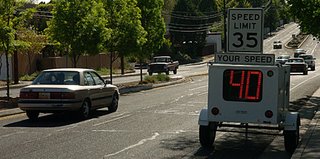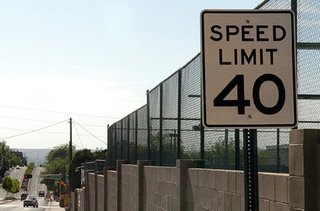 Didn’t we just do this?
Didn’t we just do this?On Saturday, April 15, 2006, I posted an entry about mobile radar and the lack of a license plate on its trailer.
The mobile radar unit showed up in my neighborhood on Westbound Indian School Rd. and was warning drivers of their speed.
The mobile radar unit serves a very worthwhile purpose in reminding motorists of the speed limit in a particular area. Many drivers check the accuracy of their speedometer against the unit’s display.
The unit shows a 35 MPH speed limit sign with a red flashing warning set at 40 MPH.
 What’s wrong? It’s a 40 MPH speed zone. Two blocks East there is this 40 MPH speed limit sign.
What’s wrong? It’s a 40 MPH speed zone. Two blocks East there is this 40 MPH speed limit sign.Several years ago there was a difficult community fight in getting the speed reduced for the school crossing at Montezuma Elementary School on the corner with Richmond Dr. N.E.
After a long and painful battle, the speed limit was reduced from 40 MPH to 35 MPH for a couple of blocks on either side of the school crossing and a stop light was also erected.
The manual of Uniform System of Traffic Control Devices approved by the State Highway Commission indicates that a black on white speed zone sign is legal maximum speed within that zone, while black on yellow means the indicated speed is simply a warning.
The city’s traffic code indicates that before a speed limit may be changed, it must be determined, “upon the basis of an engineering and traffic investigation.” This means when the mobile radar unit was set up showing a 35 MPH speed limit, the following occurs.
The police department arbitrarily and inappropriately changed the speed limit. It sends an inaccurate message; that the speed limit was different than what it had been just before the unit arrived and what it would be when the unit was removed. The police are messing with the driving public’s collective perceptions of what the law is. The credibility gap widens.
There are several Draconian efforts afoot to punish drivers through the use of technology. Obvious mistakes like this raise questions of how reliable those technological tools are used.
No comments:
Post a Comment